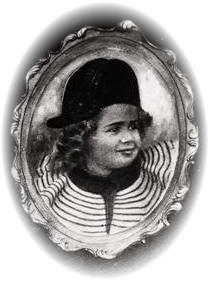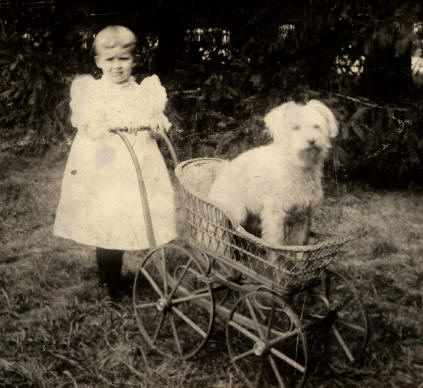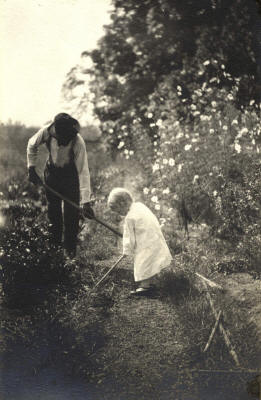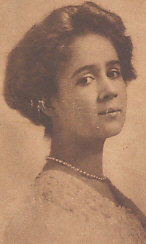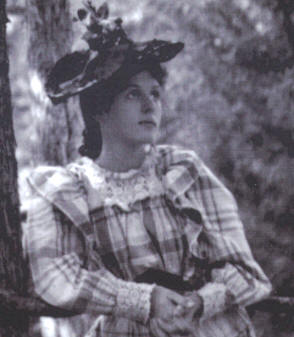Hattie Cochran
(November 24, 1890-January 2, 1975)
Real-life model for Lloyd Sherman,
in Annie Fellows Johnston’s “Little Colonel” series
Hattie (Harriet) Cochran of Pewee Valley,Kentucky
the real-life “Little Colonel” at age 5, 1896.
“Along this street one summer morning, nearly thirty years ago, came stepping an old Confederate Colonel. Every one greeted him deferentially. He was always pointed out to new comers. Some people called attention to him because he had given his right arm to the lost cause, some because they thought he resembled Napoleon, and others because they had some amusing tale to tell of his eccentricities. He was always clad in white duck in the summer, and was wrapped in a picturesque military cape in the winter.
This morning a child of delicate flower-like beauty walked beside him. She was pushing a doll buggy in which rode a parrot that had lost some of its tail feathers, and at her heels trailed a Scotch-and-Skye terrier.
“She’s her grandfather all over again,” remarked a lady in one of the carriages, “temper, lordly manners, imperious ways and all. I call her ‘The Little Colonel.’ There’s a good title for you, Cousin Anne. Put her in a book.”
– Annie Fellows Johnston, In her autobiography, Land of the Little Colonel (1929)
Shirley Temple may have played the title role in Twentieth Century Fox’s 1935 box office hit, “The Little Colonel,” but it was Hattie Cochran, a small girl living in Pewee Valley, who inspired Annie Fellows Johnston to pen the original “Little Colonel” story in 1895. The author’s first glimpse of Hattie with her maternal grandfather, Civil War veteran Colonel George Washington Weissinger, is described in the passage above from Johnston’s autobiography, Land of the Little Colonel.
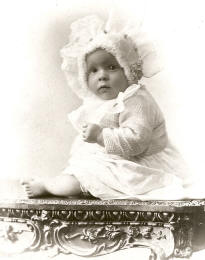
Hattie Cochran as a baby in the winter of 1890-91 from Isabelle Dayton’s private collection. She is a descendent of Hattie Cochran’s great-uncle and the Old Colonel’s brother, Harry Weissinger
Nearly half a century later, Hallie Burge Jacob, Annie Fellows Johnston’s niece by marriage, provided another version of how the first “Little Colonel” tale came into being in this excerpt from an article, called “The Naming of a Book,” by Hamilton Howard that appeared in the September 11, 1943 “Courier-Journal:”
“Hattie Cochran, the original “Little Colonel” of literary fame, was, as anybody in Pewee Valley would tell you, a cute child but “bad as she could be.”
When the Little Colonel was three and Hallie Burge, now Mrs. Donald Jacob of Louisville, was just entering her teens, Mrs. Cochran brought Hattie over to visit Mrs. Burge and Annie Fellows Johnston. Mrs. Johnston, later to become author of the famous Little Colonel series of books, was staying at the old Burge Place visiting the Burges, cousins of Mr. Johnston.
People said little Hattie Cochran was just like her grandfather, Colonel Weissinger, who had a “vile temper and cursed every breath he took.” Hattie didn’t want to go home that afternoon. She dragged back, screamed, and sat down on the floor, beating it with her tiny heels.
Mrs. Burge turned to Mrs. Johnston, “Now, there,” she said, “Just write a book about that! And call it The Little Colonel!”
Hattie Cochran, with Fritz in her doll buggy, as she first appeared to Annie Fellows Johnston. From “Land of the Little Colonel,” published in 1974 by Mrs. John S. Smith
from Fox Film Corporation Scrapbook by the Little Colonel Productions, Inc.
The Little Colonel’s descriptions of the fictional Lloyd Sherman mirror many aspects of the real-life Hattie Cochran, from her constant companion, the Scotch-and-Skye terrier, Fritz (shown in the photo above), to the hot temper she inherited from her grandfather.
From Chapter I, when Lloyd Sherman first meets her grandfather, Colonel Lloyd in the story:
“As the Colonel came nearer she tossed another berry into the dog’s mouth. A twig snapped, and she raised a startled face toward him.
“Suh?” she said, timidly, for it seemed to her that the stern, piercing eyes had spoken.
“What are you doing here, child?” he asked, in a voice so much kinder than his eyes that she regained her usual self-possession at once.
“Eatin’ ‘trawberries,” she answered, coolly.
“Who are you, anyway?” he exclaimed, much puz
its face, with eyes that were startlingly human.
“‘Peak when yo’ah ‘poken to, Fritz,” she said, severely, at the same time popping another luscious berry into her mouth.
Fritz obediently gave a long yelp. The Colonel smiled grimly.
“What’s your name?” he asked, this time looking directly at her.
“Mothah calls me her baby,” was the soft-spoken reply, “but papa an’ Mom Beck they calls me the Little Cun’l.”
“What under the sun do they call you that for?” he roared.
“‘Cause I’m so much like you,” was the startling answer.
“Like me!” fairly gasped the Colonel. “How are you like me?”
“Oh, I’m got such a vile tempah, an’ I stamps my foot when I gets mad, an’ gets all red in the face. An’ I hollahs at folks, an’ looks jus’ zis way.”
She drew her face down and puckered her lips into such a sullen pout that it looked as if a thunder-storm had passed over it. The next instant she smiled up at him serenely.
The Little Colonel & Walker(?) work near the strawberry patch
from Fox Film Corporation Scrapbook by the Little Colonel Productions, Inc.
From Chapter III, when the Little Colonel is caught making mud pies on the front steps of her grandfather’s stately home, The Locust:
“…The same temper that glared from the face of the man, sitting erect in his saddle, seemed to be burning in the eyes of the child who stood so defiantly before him.
The same kind of scowl drew their eyebrows together darkly.
“Don’t you talk that way to me,” cried the Little Colonel, trembling with a wrath she did not know how to express.
Suddenly she stooped, and snatching both hands full of mud from the overturned pie, flung it wildly over the spotless white coat.
Colonel Lloyd gasped with astonishment. It was the first time in his life he had ever been openly defied. The next moment his anger gave way to amusement.
“By George!” he chuckled, admiringly. “The little thing has got spirit, sure enough. She’s a Lloyd through and through. So that’s why they call her the ‘Little Colonel,’ is it?”
There was a tinge of pride in the look he gave her haughty little head and flashing eyes.
“There, there, child!” he said, soothingly, “I didn’t mean to make you mad, when you were good enough to come and see me. It isn’t often I have a little lady like you pay me a visit.”
“I didn’t come to see you, suh,” she answered, indignantly, as she started toward the gate. “I came to see May Lilly. But I nevah would have come inside yo’ gate if I’d known you was goin’ to hollah at me an’ be so cross.”
She was walking off with the air of an offended queen, when the Colonel remembered that if he allowed her to go away in that mood she would probably never set foot on his grounds again. Her display of temper had interested him immensely.
Hattie Cochran as a young lady, 1905
The Little Colonel’s Christmas Vacation
Hattie Cochran herself noted how true-to-life the first book in the “Little Colonel” series was in the following transcript of a letter to a Shelbyville fan, Elizabeth Kathleen Hansborough, written in 1907. The letter now resides in The Filson Historical Society’s collection in Louisville, Kentucky:
July 17, 1907
Pewee Valley, Ky.
Dear Elizabeth—
I am the real Little Colonel though everything in the books are not true. 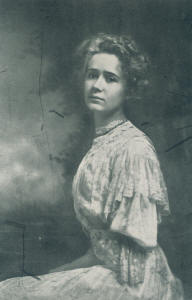
You ask is my home like Mrs. Johnston describes it, sorry to say it is not, though there is a real Locust not far from where I live, where my Grandfather, Colonel Weissinger used to stay. Perhaps you know of Mr. Harry Weissinger who has a summer home in Shelbyville, he was my Grandfather’s brother.
All of the Waltons are real, and the Beeches, the name of their place, is right in Pewee. Also the haunted house of Hartwell Hollow.
Mrs. MacIntyre really Mrs. Craig lives opposite Mrs. Lawton, her daughter. I suppose you know they are general Lawton’s family and Miss Allison or Miss Craig is my teacher. She is just as lovely a character out of the stories as in.
The MacIntyre boys are the Culbertsons of Louisville and Rob Moore’s real name is Muir Semple. He does not live in Pewee, but Oaklea is here and he often visits his cousin Anna Moore or Anna Muir.
Betty is real but I do not know her.
Mrs. Johnston has met girls like Eugenia and Joyce and thought she would use their characters in the Books of course you know everything in fiction cannot be true.
Phil is also fiction and so is Mary Ware.
Mom Beck is real and so was Fritz (her Scotch and Skye terrier) but is now dead.
The Little Colonel or the first book was practically the truest and all the others, some parts are true and others are not.
Perhaps you think I am grown but I am not, as I am only sixteen, though in the books she has made me much older.
Hoping you will not be disappointed in knowing the real truth.
Very Sincerely,
Hattie Cochran
(Note that in 1907, Annie Fellows Johnston published the “Little Colonel’s Knight Comes Riding” in which Lloyd gets married. The real Little Colonel didn’t marry until 1912.)
Much later in life, she reminisced about the books that made her famous in this interview excerpted from a “Louisville Times” story called “The Little Colonel Gives Old Family Recipes” written by Helen Leopold, women’s editor:
“… The other day when Mrs. Dick was hunting up recipes for us to use she realized that Mrs. Johnston got the idea for the first Little Colonel book when she, then Hattie Cochran, was five years old.
“Our family was spending the summer at Pewee Valley, which used to be sort of a Louisville summer resort. Mrs. Johnston’s home was there.”
“I was so much like my grandfather, Colonel George Weissinger (he was an imperious, peppery sort of man) that it amused Mrs. Johnston. She always called me the Little Colonel, even before the book was started.
“She used to watch me ride in the saddle with my grandfather on his horse, Maggie Boy, and she’d see me carry my polly parrot around on a broom handle and wheel Fritz, my dog, in a doll carriage.”
Her reminiscences regarding how the series originated and its unanticipated popularity can be found in “Mrs. Albert Dick Remembers” by Yvonne Eaton, which ran in the August 7, 1969 issue of the “Courier-Journal:”
…”You know Mrs. Johnston was so surprised when she heard from the publisher how well they (the first book in the series, “The Little Colonel”) was selling,” Mrs. Dick said. “she began writing for she had two children [note: there were actually three: Rena, Mary and John] to support. Her husband was killed” in a flood. [NOTE: this is NOT true according to Annie Fellows Johnston’s autobiography] “Her son had TB and that’s why she went to Arizona,” which was the setting for some of the series.
Mrs. Dick recalled that she first met Annie Fellows Johnston as a child in the middle 1890s. She and her mother, the late Mrs. John Hoadley Cochran, stayed at a rooming house owned by Mrs. Johnston’s aunt [Burge] while the Cochrans were looking for a house in which to live in Pewee Valley.
“One day I came into the dining room and stamped my foot about something. Mrs. Johnston said, ‘Amelia (Mrs. Dick’s mother) I have the title for my story I’m writing about Hattie and her grandfather.’” In the books the Little Colonel’s name is Lloyd Sherman.
Mrs. Dick’s maternal grandfather, Col. George Weissinger, was a peppery, determined gentleman whose young granddaughter Hattie took after him in temperament.
Asked if she had temper tantrums, Mrs. Dick said that she didn’t know what that was, but indeed she used to lie on the floor and beat her heals and head – “Why every child does that.”…
Hattie Cochran was born on November 24, 1890 to John Hoadley and Amelia Weissinger Cochran (Papa Jack and Mrs. Sherman Sherman in the “Little Colonel” books). Her parents had been married less than a year when their daughter was born, according to Oldham County marriage records, which list their wedding date as March 6, 1890.
The family lived in a cottage that still stands on Pewee Valley’s Maple Avenue. Just as Annie Fellows Johnston describes the fictional Sherman cottage, snowball bushes once lined the front walk. The Cochrans lived there until 1909, when they moved to Louisville, where they lived several years in Apartment 1 of the Owens-Hill building at 1300 Sixth Street, according to the Caron Directory. A1910 letter written by Mamie Lawton (“Mrs. Walton”) to Annie Fellows Johnston mentions their move to the city:
… Hattie Cochran spent last night with the girls, and they had four nice beaux to supper — and a jolly time together after the boys left on the 9:30 car.
We miss the Cochrans very much in “Cranford.” You know they wouldn’t sign the contract for their apartments until the landlord inserted a special clause permitting “Bob-Angel” & “Buzz” the cat to enjoy its comforts with them.
Bob promptly lost himself, and the family were in a terrible state. Amelia returning to Pewee, and the others searching in every direction they could think of – Bob finally turned up, none the worse except for mud and dirt. The prodigal was carried in & laid tenderly on the clean white bed and petted – then bathed in the family tub, fed nice cream and petted some more…

Though it looks like the Little Colonel astride Tar Baby, this 1970 photo shows Amy Alsop riding Tom Terrific, Sally
Tanselle’s pony, alongside the Little Colonel’s cottage. The Tanselle family moved into the cottage that year.
Photo from “A Place Called Pewee Valley,” published by the Pewee Valley Centennial Commission in 1970
As a child, Hattie attended Pewee Valley’s Villa Ridge School, taught by Miss Fanny Craig, Miss Allison in the tales. Later, she finished her schooling at Miss Kendrick’s School in Cincinnati, Ohio, according to this profile that appeared in “Kentucky Lives: the Blue Grass State’s Who’s Who,” by Hambleton Tapp, published in 1966:
DICK, HATTIE COCHRAN (Mrs. Albert C.), homemaker, 301 O’Read Road, Louisville. She was born in Louisville, Kentucky, the daughter of John Hoadley Cochran and Amelia (Weissinger) Cochran. Mrs. Dick was educated at Miss Kendrick’s School in Cincinnati, Ohio. On October 3, 1912, she was married to Albert C. Dick, and they are the parents of two sons, Albert C. Dick, Jr., and J.H. Cochran Dick. Mrs. Dick has devoted her life to the service of her family, community and friends. She has set an example for all of those who have been privileged to know her in her gracious way of life. She holds membership in Louisville Country Club and the Pendennis Club. Politically, Mrs. Dick is a member of the Republican Party.
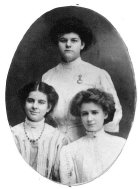
Misses Lawton and the Little Colonel
Allison Walton=Frances Lawton (standing)
Kitty Walton=Catherine Lawton & the Little Colonel (seated)
(click on picture for more)
“Sunshine and Shadow,” the autobiography of Cary Hoge Mead privately published in 1983, includes some insights into Hattie’s debutante days. Hattie came out with Cary’s sister, Bess Hoge:
Sunshine and Shadow,” pgs. 68-69
“Bess had made her debut that year and was quite a ‘toast.’ She had much of Mamma’s wit and charm, and things were generally gay and full of laughter wherever she was. ..They (the debutantes) were a delightful group that year, and they all had a glorious time; Eliza Grinstead, whom William (Cary’s brother) described as having a flower-like face and stem-like figure — Julia Kinkead, who was a redhead and full of fun — Lala Swearingen, also a redhead — Nellie Ganter, a darling — Hattie Cochran (the Little Colonel) and her cousin, Blanche Weissinger Smith…
More details about her debutante year can be found in a clippings scrapbook compiled by the Little Colonel Doll Club now at the Louisville Free Public Library’s main branch on York Street:
The Little Colonel was a great favorite with the girls who came out that year and was included in most of their parties. Mrs. Robert Tyler who 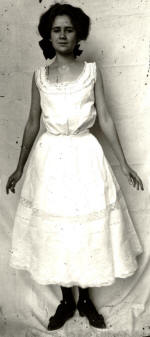 for many years has entertained the season’s debutantes, gave a dinner on Thanksgiving Day in Hayfield for Miss Cochran. A party to see Ethel Barrymore in “Mid-Channel” at Macauley’s followed by a supper in The Seelbach Rathskeller was given by Mrs. Amanthus Smith Jungbluth. Mrs. Heywood Cochran was hostess at a buffet supper and Mr. and Mrs. Thomas Floyd Smith gave a dinner-dance for the debutante.
for many years has entertained the season’s debutantes, gave a dinner on Thanksgiving Day in Hayfield for Miss Cochran. A party to see Ethel Barrymore in “Mid-Channel” at Macauley’s followed by a supper in The Seelbach Rathskeller was given by Mrs. Amanthus Smith Jungbluth. Mrs. Heywood Cochran was hostess at a buffet supper and Mr. and Mrs. Thomas Floyd Smith gave a dinner-dance for the debutante.
It was during her season that Miss Cochran was an attendant in the wedding of her cousin, the late Helen Cochran Donigan, and Isaac Hilliard on November 2 in Calvary Church. The rich green satin Empire bridesmaid gown veiled in crewstal dew drop tulle with a silver cord about hr waistline seemed particularly to suit her delicate beauty. And from under her large green beaver hat with its black tulle bow trimming, one caught a glimpse of her soft wavy brown hair, with a cluster of puffs caught at the nape of the neck.
Among the girls who made their debut that year were Bessie Hoge (Mrs. Edmund Meriwether, whose daughter, Elizabeth, is one of this season’s debutantes); Elizabeth Bullitt (Mrs. E.T. Hutchings), Fanny Brandeis, Blanche Weissinger Smith (Mrs. Peyton H. Hoge, Janet Colson (Mrs. Harry W. Embry), Anna Cartledge (Mrs. Richard R. Williams), Eliza Helm Grinstead (Mrs. L.L. Warren), Julia Hunt Johnston (Mrs. Boyd Martin), Carolyn Hulbert, Julia Kinkead (Mrs. Baylor Landrum of Lexington), Mary Lucy Hull, Jane tJoyes, Nellie Elizabeth Ganter (Mrs. A.C. Schriener of Kerrville, Texas), Catherine Castner (Mrs. Frank Towsley of Norville, Tenn.), Lala Swearingen (Mrs. Ralph C. Gifford), Mary Rogers Lyons (Mrs. Robinson Brown), and two out-of-town girls, Aleene Murphy of Germantown, Penn., who spent the winter with Mr. and Mrs Lawrence Richardson, and Eliza McMullin, who was the guest of Mr. and Mrs. Samuel Bainbridge Richardson.
On October 3, 1912, Hattie married Albert Conrad Dick, a 1907 graduate of Centre College in Danville and later, of the University of Louisville law school in 1909, according to this 1912 “Who’s Who in Louisville,” profile written prior to their wedding:
DICK, ALBERT C. – Lawyer. Born in Louisville, December 31, 1885. son of Albert M. and Emma A. Dick. Unmarried. Graduate, Centre College, 1907; University of Virgiana and University of Louisville Law Departments, 1908-09. Business address: Kenyon building. Residence: 1477 South Third Street
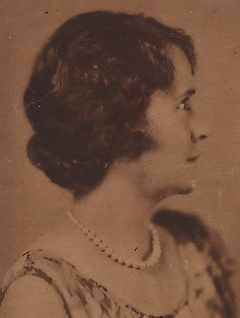
The Little Colonel as an adult, Mrs. Albert Conrad Dick
“Mrs. Albert Conrad Dick, 2127 Edgehill Rd
formerly Miss Hattie Cochran
the heroine and original of “Little Colonel”
who takes the part of Lloyd Sherman
in the Little Colonel series (ca. 1928)”
From The Sunday Herald Post
Louisville, Kentucky, December 23, 1928
Photos by Standiford (Samuel Culbertson Mansion Collection)
Another former Pewee, Emmet O’Neal, who would later represent Kentucky in the U.S. House of Representatives and his nation as ambassador to the Philippines, was Albert Dick’s best man. The two were room mates at Centre College.
By 1936, her husband was an insurance executive, heading the insurance firm of Albert C. Dick Co. in the Columbia Building and the Dicks were living at 2137 Edgehill Road in Louisville. More information about Albert Dick is available from a profile prepared by the Citizens Historical Association of Indianapolis on December 25, 1943 that resides at The Filson Historical Society:
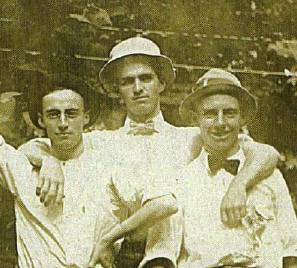
Left to right, George Looms, Emmet O’Neal and Albert Conrad Dick. Emmet and Albert were room mates at Centre College in Danville, Ky.
This photo was taken July 12, 1909 in Dawson Springs.
From the private collection of Mary O’Neal.
Profile of Albert C. Dick,
Proprietor, Louisville Barrel & Box Company
109 North Twenty-first Street, Louisville, Kentucky
December 25, 1943
Albert C(onrad) Dick, son of Albert Mallory and Emma Albertine (Conrad) Dick, was born in Louisville, Ky., Dec. 31, 1885.
Albert Mallory Dick, son of Samuel P. and Frances Dick, was born in 1858 in Louisville, Ky., where he died June 18, 1918. He was a merchandise broker. His wife, Emma Albertine (Conrad) Dick, was born in 1863 in Louisville, Ky., where she died Dec. 18. 1931. She was the daughter of Theophilus and Mary (Krieger) Conrad. Albert Mallory and Emma Albertine (Conrad) Dick were the parents of 2 children, Albert Conrad being the elder.
Theophilus Conrad, father of Emma Albertine (Conrad) Dick, was born in Alsace-Lorraine, and later came to the U.S., settling in New Orleans, La. He subsequently moved to Louisville, Ky., where he became pres. of the Conrad Tanning Co. His wife, Mary (Krieger) Conrad, was born in Indiana. (NOTE: Theophilus Conrad built the Conrad-Caldwell House, a magnificent Richardsonian Mansion on Old Louisville’s St. James Court known as “Conrad’s Castle” for the extravagant sum of $75,000. The house is open to the public for tours from noon to 4 p.m. Sunday, Wednesday, Thursday and Friday and from 10 a.m. to 4 p.m. on Saturday. Admission charge is $5 for adults, $4 for seniors and $3 for students.)
Samuel P. Dick, father of Albert Mallory Dick, was born in Scotland and later came to the U.S., settling in Louisville, Ky. when a young man. He founded and became president of the Dick-Middleton Tobacco. His wife, Frances Dick, was a native of Pennsylvania.
Albert C. Dick, the subject of this sketch, attended grade and high schools. in Louisville, Ky., being graduated from DuPont Manual Training High School. in 1905. He received. an A.B. deg. from Centre College, of Danville, Ky. in 1907, an L.L.B. degree. from the University of Virginia in 1909 and an LL.B. deg. from the University of Louisville in 1910. He engaged in the practice of law in Louisville from 1910 until 1915, and in the latter year entered the general insurance business in Louisville. In 1941 he purchased the Louisville Barrel & Box Co, of which he is sole owner. The company processes cooperate and steel drums, which are sold internationally. Mr. Dick, who is a Republican, is a member of the following: Delta Kappa Epsilon; Pendennis Club; Louisville Country Club; and Unitarian Church.
On October 3, 1912, Mr. Dick married Hattie Hoadley Cochran, who was born in Louisville, Nov. 24, 1890. Her parents, Hoadley and Amelia (Weissinger) Cochran are dead. Hoadley Cochran was a steam engineer. Mr. and Mrs. Dick are the parents of two children: (1) Albert Conrad, Jr., who was born Sept. 17, 1915. He is serving with the rank of 2nd lieutenant in the U.S. Army Air Corps. (2) John H. Cochran, who was born Sept. 20, 1920. He is serving in the Engineer Corps of the U.S. Army.
[Left: The Little Colonel at age 78]
Even as the years passed and the popularity of Annie Fellows Johnston’s books began to wane, Hattie Cochran Dick remained inextricably linked with the “Little Colonel.” The 1969 “Courier-Journal” article by Yvonne Eaton described the impact that notoriety on her life:
Her hair is now white. The curls are still there. And almost uncanny is the resemblance still of the Little Colonel to the Shirley Temple who portrayed the famous Little Colonel in the movie in the mid-‘30s.
One wonders if Mrs. Albert C. Dick, Sr., now 78, would like people to forget that she was the inspiration for Annie Fellows Johnston’s famous “Little Colonel” series.
With a little prodding, however, the former Hattie Cochran will talk about the Little Colonel in a matter-of-fact way. But some of the mannerisms of the Little Colonel appear to remain, such as a little bow as guests leave.
Mrs. Dick doesn’t think the fame which the popular books brought to her affected her life “in any way at all. Children don’t pay any attention to things like that. We didn’t think anything about it….I never felt like a celebrity.”
Nevertheless through the years she has been asked many, many times about the characters and incidents in the books and the relationships to real people. Or what it felt like being the Little Colonel. And to autograph books or to pose for one more picture. Or to grant still another interview.
She does answer some of the letters (about 10 a year now compared to about 25 a few years ago) but not all. “One would tell another and then the letters would start to pile up. And my hand is almost paralyzed.” Mrs. Dick had a stroke about three and a half years ago.
One of her most recent replies was to a woman who teaches in a college in San Antonio who later wrote Mrs. Dick: “My mother who is now 77, both my sisters and I grew up reading and loving the stories about the Little Colonel and day dreaming that we knew her. And I am sure this is true of thousands of other girls, too…” And she was right.
Later in the interview, however, she noted that neither her two children nor her three grandchildren were impressed enough by her role in inspiring the tales to actually read them:
As for her grandchildren’s reading the books, they’re “just like my own boys (Albert C. Dick, Jr. and J.H. Cochran Dick) were. They were so afraid they’d be called sissies if they read that kind of books. Boys are such fools about things like that, I think, though, they know little parts of them.”
Albert Conrad Dick died in 1955, Hattie in 1975. Both are buried in Cave Hill Cemetery. Hattie Cochran Dick’s obituary was published in the Courier-Journal on January 3, 1975:
Mrs. A.C. Dick, ‘Little Colonel’ Inspirer, Dies
Mrs. Albert C. Dick, who as a young girl inspired the famous “Little colonel” stories by Annie Fellows Johnston, died Thursday afternoon at National Health Enterprises Northfield.
She was 84.
It was in the 1980s that Mrs. Dick, then Hattie Cochran, met Mrs. Johnston in Pewee Valley and the Little Colonel was born.
Her name in the stories was Lloyd Sherman, and Pewee Valley became Lloydsboro Valley, but the places and people in the books actually existed in the town where Hattie Cochran grew up.
It was said that she got her Little Colonel nickname because she inherited her colonel grandfather’s imperious manner and determination to get his own way.
In 1969, Mrs. Dick was asked if she did have some of those traits as a child, if she did have temper tantrums. She replied that she remembered lying on the floor and kicking, but added: “Why every child does that.”
Shirley Temple played the role in a movie in the mid-30s.
Now, there is a Little Colonel Playhouse in Pewee Valley. It is a revamped general store.
Mrs. Dick was a member of the National Society of Colonial Dames of America and a former member of the Pendennis Club, Louisville Country Club and Junior League of Louisville.
She was a charter member of the Cabbage Patch Settlement House.
Survivors include two sons, Albert C. Dick, Jr. and J.H. Cochran Dick; three grandchildren, Harriett C. Dick, George C. Dick and David C. Dick.
Private graveside services will be at Cave Hill Cemetery at 11 a.m. Saturday.
The family requested that expressions of sympathy take the form of contributions to charity.
During her lifetime, Hattie Cochran Dick was well known for her Southern hospitality and the regional fare she served her guests. To try seven of her recipes, visit Cooking with the Little Colonel http://www.littlecolonel.com/recipes.htm.
Thanks to Alex Luken for sending us more articles about Hattie Cochran Dick’s life.

Mom Beck, The Walton’s and the Little Colonel at a tea at Clovercroft
Being winsome
click here for “Mrs. Sherman & Papa Jack”
